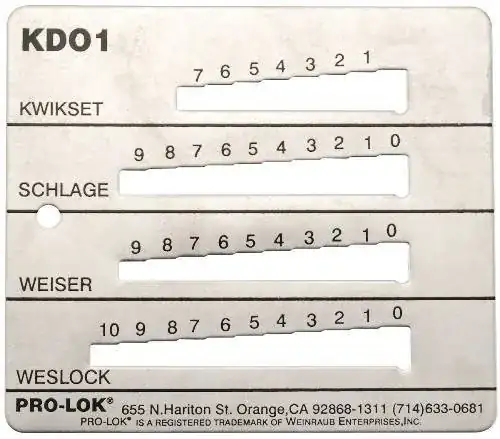A Yahoo! answers user suggested that there are 5^5 possible unique configurations for a physical key, but the answer wasn't sourced. I wondered if anyone had similar numbers for how many possible key combinations there are. I ask because, it seems impossible that there can be a unique key for every lock in the world, and I'd like to know how many different key configurations a thief would have to try to have a certainty of cracking the lock (if the thief didn't want to force the lock in another way.)
3 Answers
Pictured below is a key decoder, used by lock smiths to identify the height of each cut in a key, allowing the key smith to determine the code used to describe a particular key.
As you can see, different companies use different sets of codes, Kwikset having only 8 possible codes (0 through 7) and Weslock having the most with 11 (for this subset of all lock manufacturers), with each code referring to a particular cut depth. While the math has already been described and corrected in other answers and the complexities of key design have been referenced through a (peer-reviewed?) paper, this key decoder gives some confirmation to the numbers previously used, stating there are about 10 possible cut depths on a key.
- 123,438
- 55
- 284
- 319
- 131
- 1
- 2
Here is a very short Youtube Video on how keys work. Given the space available for the length and number of the pins, and operational room for error there are only so many key combinations possible. Given all the different variables involved it's certainly possible for every person on the planet to have a unique lock, it's highly impractical.
Most vendors distribute key/lock combinations by region. Car companies (or house door lock manufacturers) for example might have 200,000 possible key/lock pairs but could redistribute the same combinations on both the east and west coasts since the likelihood of 2 people with the same key/lock combos meeting and then realizing they're the same are extremely low. Generally keys are created using "codes" where a number represents the height of the peaks on the key.
So given say 5 pins with say 10 different height possibilities you're looking at 10^5 unique possibilities. You can then add another dimension of complexity by putting ridges on the sides of the keys. I think you see where this is going. A lock could have more pins or more height possibilities depending on manufacturing accuracy and size of the lock.
If someone was to somehow have every possible key combination in one place, there is NO WAY they would be able to transport it. Let alone go unnoticed. It would take multiple dump trucks to move even a portion of the keys.
-
8Five pins with ten height possibilities is only 10^5=100,000 (not 5^10, which is about ten million). Since a typical door key fits inside a cuboid of about 5cm x 2.5cm x 2mm, a hundred thousand of them would take up only a quarter of a cubic metre. That's nothing like "multiple dump trucks". Ten height possibilities for a single pin also seems like an over-estimate. – David Richerby Jul 26 '14 at 18:43
-
1So my math is actually quite bad here, but the point I was illustrating still remains. It's pretty much physically impossible to surreptitiously carry around even 100,000 keys. Even at only .2 ounces each that's still over 1,000 pounds. Thanks for pointing out the errors in my math by the way. – JekwA Jul 28 '14 at 16:19
-
@JekwA I think you meant to say 10^5. First pin has ten different possibilities multiplied by second pin has ten different possibilities multiplied by third pin has ten different possibilities and so on...10 x 10 x 10 x 10 x 10 = 10^5. – user171453 Jan 20 '17 at 12:13
-
Theoretically you could build a device which you stick into a door lock that tries all possible combinations by changing shape. No need to carry around 100k keys. (Though given how easy it is to pick most locks, such a device is probably unnecessary.) – Ajedi32 Dec 06 '17 at 16:24
-
@Ajedi32, there are actually some picks for certain lock types that do exactly what you describe. The pick has an adjustment for each pin so you can set it to the correct code and open the lock. – JPhi1618 Feb 27 '18 at 16:48
There's paper on the subject available to read at jstor.org and the answer isn't quite as simple as {the number of cuts}^{possible cut depths} because there are cases where one cut will remove the possibility of an adjacent depth and so forth. It does get complicated though! There are so many different factors to take into account that it's likely each lock/key combo is pretty unique although some cheap padlocks could have the same shape if the manufacturer is cutting corners.
